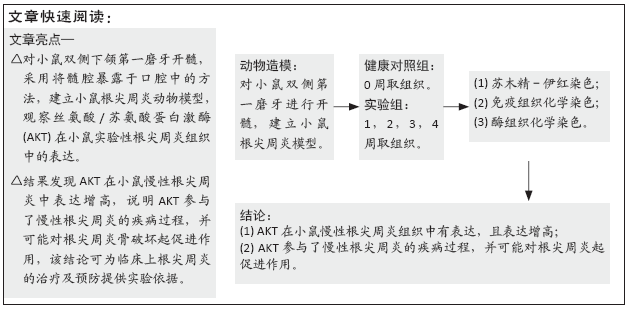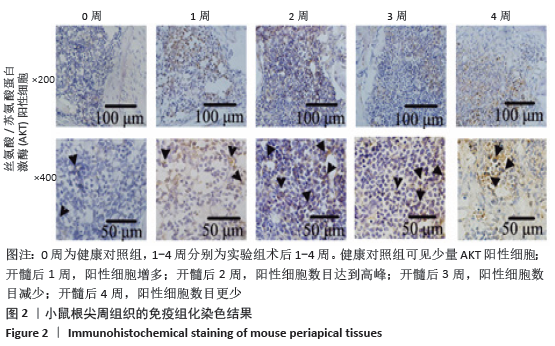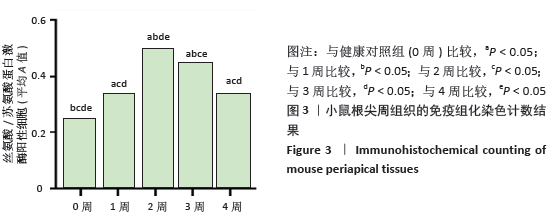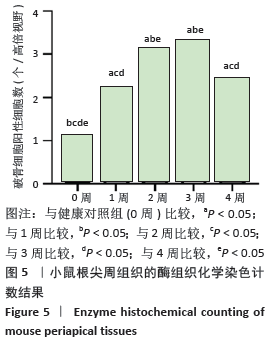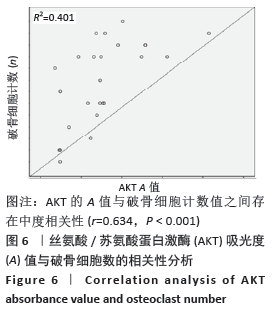[1] MAKKAWI H, HOCH S, BURNS E, et al. Porphyromonasgingivalis stimulates TLR2-PI3K signaling to escape immune clearance and induce bone resorption independently of MyD88. Front Cell Infect Microbiol. 2017;7:359.
[2] ZHOU Y, CHEN M, RICUPERO CL, et al. Profiling of Stem/Progenitor Cell Regulatory Genes of the Synovial Joint by Genome-Wide RNA-Seq Analysis. Biomed Res Int. 2018;2018:9327487.
[3] PAN ST, QIN Y, ZHOU ZW, et al. Plumbagin induces G2/M arrest, apoptosis, and autophagy via p38 MAPK-and PI3K/Akt/mTOR-mediated pathways in human tongue squamous cell carcinoma cells. Drug Design Dev Ther. 2015;9:1601.
[4] YAMANAKA Y, CLOHISY JC, ITO H, et al. Blockade of JNK and NFAT pathways attenuates orthopedic particle-stimulated osteoclastogenesis of human osteoclast precursors and murine calvarialosteolysis. J Orthop Res. 2012;31(1):67-72.
[5] KIM TH, CHOI SJ, LEE YH, et al. Combined therapeutic application of mTOR inhibitor and vitamin D(3) for inflammatory bone destruction of rheumatoid arthritis. Med Hypoth. 2012;79(6):757-760.
[6] ZHONG JT, YU J, WANG HJ, et al. Effects of endoplasmic reticulum stress on the autophagy, apoptosis, and chemotherapy resistance of human breast cancer cells by regulating the PI3K/AKT/mTOR signaling pathway. Tumour Boil. 2017;39(5):1010428317697562.
[7] KAWAMURA N, KUGIMIYA F, OSHIMA Y, et al. Akt1 in osteoblasts and osteoclasts controls bone remodeling. PloS One. 2007;2(10):e1058.
[8] SHI ZM, HAN YW, HAN XH, et al. Upstream regulators and downstream effectors of NF-κB in Alzheimer’s disease. J Neurol Sci. 2016;366: 127-134.
[9] HOESEL B, SCHMID JA. The complexity of NF-κB signaling in inflammation and cancer. Mol Cancer. 2013;(12):86.
[10] ZHANG H, SHAN Y, WU Y, et al. Berberine suppresses LPS-induced inflammation through modulating Sirt1/NF-κB signaling pathway in RAW264.7 cells. Int Immunopharmacol. 2017;52:93-100.
[11] lin c, shao y, zeng c, et al. Blocking PI3K/AKT signaling inhibits bone sclerosis in subchondral bone and attenuates post‐traumatic osteoarthritis. J Cell Physiol. 2018;233(8):6135-6147.
[12] CHEN L, HUANG M, TAN J, et al. PI3K/AKT Pathway Involvement in the Osteogenic Effects of Osteoclast Culture Supernatants on Preosteoblast Cells. Tissue EngPart A. 2013;19(19-20):2226-2232.
[13] SUGATANI T, HRUSKA KA. Akt1/Akt2 and mammalian target of rapamycin/Bim play critical roles in osteoclast differentiation and survival, respectively, whereas Akt is dispensable for cell survival in isolated osteoclast precursors. J Biol Chem. 2005;280(5):3583-3589.
[14] BOYCE BF. Advances in osteoclast biology reveal potential new drug targets and new roles for osteoclasts. J Bone Miner Res. 2013; 28(4):711-722.
[15] JOHNSON SM, GULHATI P, RAMPY BA, et al. Novel expression patterns of PI3K/Akt/mTOR signaling pathway components in colorectal cancer. J Am Coll Surg. 2010;210(5):767-776.
[16] YEON JT, KIM KJ, SON YJ, et al. Idelalisib inhibits osteoclast differentiation and pre-osteoclast migration by blocking the PI3Kδ-Akt-c-Fos/NFATc1 signaling cascade. Arch Pharm Res. 2019;42(2):712-721.
[17] XIAO L, ZHU L, YANG S, et al. Different correlation of sphingosine-1-phosphate receptor 1 with receptor activator of nuclear factor kappa B ligand and regulatory T cells in rat periapical lesions. J Endod. 2015;41(4):479-486.
[18] Wang L, Zhang H, Dong M, et al.Role of the Btk-PLCγ2 Signaling Pathway in the Bone Destruction of Apical Periodontitis. Mediators Inflamm. 2019;2019:8767529.
[19] MOON JB, KIM JH, KIM K, et al. Akt induces osteoclast differentiation through regulating the GSK3β/NFATc1 signaling cascade. J Immunol. 2012;188(1):163-169.
[20] KE K, SUL OJ, CHOI EK, et al. Reactive oxygen species induce the association of SHP-1 with c-Src and the oxidation of both to enhance osteoclast survival. Am J Physiol Endocrinol Metab. 2014;307(1): E61-E70.
[21] CEJKA D, HAYER S, NIEDERREITER B, et al. Mammalian target of rapamycin signaling is crucial for joint destruction in experimental arthritis and is activated in osteoclasts from patients with rheumatoid arthritis. Arthritis Rheum. 2010;62(8):2294-2302.
[22] 徐杨,傅文贞,何进卫,等. AKT1基因嵌合性体细胞突变导致Proteus综合征临床研究[J].中华内科杂志,2019,58(7):508-513.
[23] KAWAMURA N, KUGIMIYA F, OSHIMA Y, et al. Akt1 in osteoblasts and osteoclasts controls bone remodeling. Plos One. 2007;2(10):1058.
[24] ULICI V, HOENSELAAR KD, AGOSTON H, et al. The role of Akt1 in terminal stages of endochondral bone formation: angiogenesis and ossification. Bone. 2009;45(6):1133-1145.
[25] PENG X, XU PZ, CHEN ML, et al. Dwarfism, impaired skin development, skeletal muscle atrophy, delayed bone development, and impeded adipogenesis in mice lacking Akt1 and Akt2. Genes Dev. 2003;17(11): 1352-1365.
[26] BRAZIL DP, YANG ZZ, HEMMINGS BA. Advances in protein kinase B signalling: AKTion on multiple fronts. Trends Biochem Sci. 2004;29(5): 233-242.
[27] MANNING BD, CANTLEY LC. AKT/PKB signaling: navigating downstream. Cell. 2007;129(7):1261-1274.
[28] LIU X, BRUXVOORT KJ, ZYLSTRA CR, et al. Lifelong accumulation of bone in mice lacking Pten in osteoblasts. Proc Natl Acad Sci U S A . 2007;104(7):2259-2264.
[29] VISWANATH K, BODIGA S, BALOGUN V, et al. Cardioprotective effect of zinc requires ErbB2 and Akt during hypoxia/reoxygenation. Biometals. 2011;24(1):171-180.
[30] ORTIZ PA, HONG NJ, GARVIN JL. Luminal flow induces eNOS activation and translocation in the rat thick ascending limb. Ajp Renal Physiol. 2004;287(2):F274-F280.
[31] CHEN JX, LAWRENCE ML, CUNNINGHAM G, et al. HSP90 and Akt modulate Ang-1-induced angiogenesis via NO in coronary artery endothelium. J Appl Physiol. 2004;96(2):612-620.
[32] 汪林芳,袁喆晨,苏芬芬,等. IRF3在绿脓杆菌感染时抑制中性粒细胞粘附的机制研究[J]. 杭州师范大学学报(自然科学版), 2019, 18(5):516-520.
[33] MAZAKI Y, NISHIMURA Y, SABE H. GBF1 bears a novel phosphatidylinositol-phosphate binding module, BP3K, to link PI3Kγ activity with Arf1 activation involved in GPCR-mediated neutrophil chemotaxis and superoxide production. Mol Biol Cell. 2012;23(13): 2457-2467.
[34] STARK AK, SRISKANTHARAJAH S, HESSEL EM, et al. PI3K inhibitors in inflammation, autoimmunity and cancer. Curr Opin Pharmacol. 2015; 23:82-91.
[35] DONG M, HU N, HUA Y, et al. Chronic Akt activation attenuated lipopolysaccharide-induced cardiac dysfunction via Akt/GSK3β-dependent inhibition of apoptosis and ER stress. Biochim Biophys Acta. 2013;1832(6):848-863.
[36] TAKAKI A, SATOSHI O, MIYUKI T, et al. Enhanced AKT Phosphorylation of Circulating B Cells in Patients with Activated PI3KδSyndrome. Front Immunol. 2018;9:568.
[37] CHEN PJ, KO IL, LEE CL, et al. Targeting allosteric site of AKT by 5,7-dimethoxy-1,4-phenanthrenequinone suppresses neutrophilic inflammation. Ebiomedicine. 2019;40:528-540.
[38] LIAN Z, HAN J, HUANG L, et al. A005, a novel inhibitor of phosphatidylinositol 3-kinase/mammalian target of rapamycin, prevents osteosarcoma-induced osteolysis. Carcinogenesis. 2019;40(2): E1-E13. |
